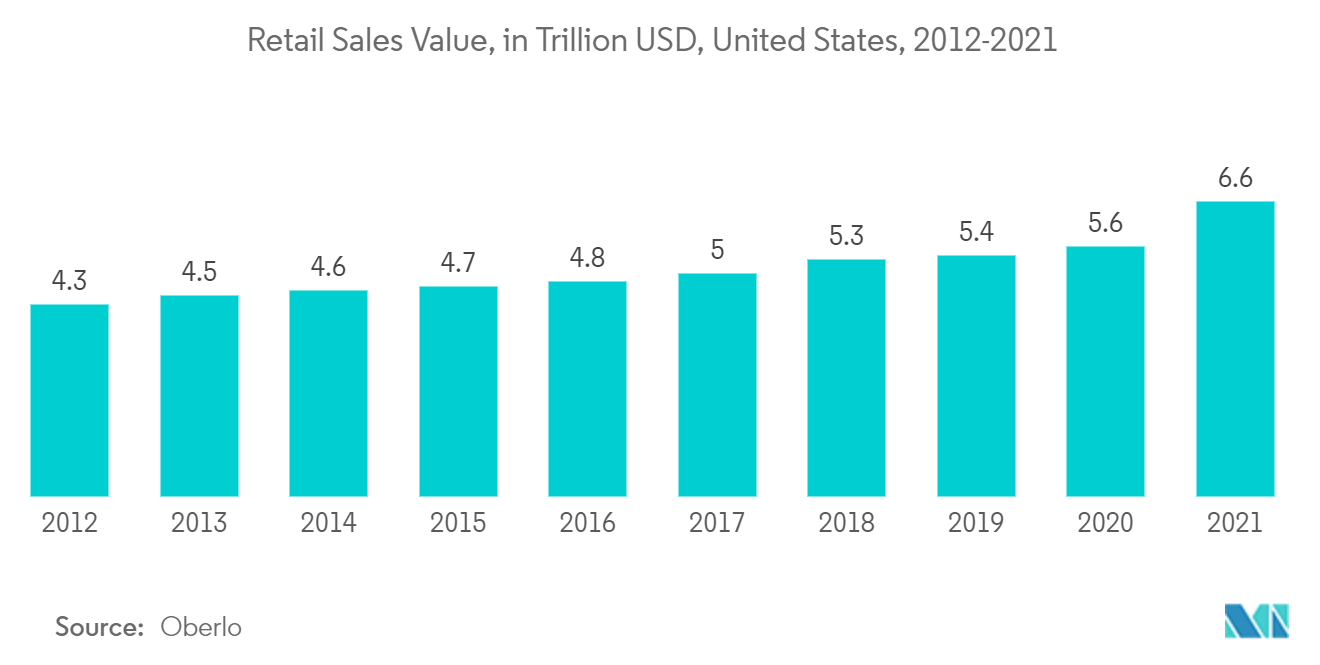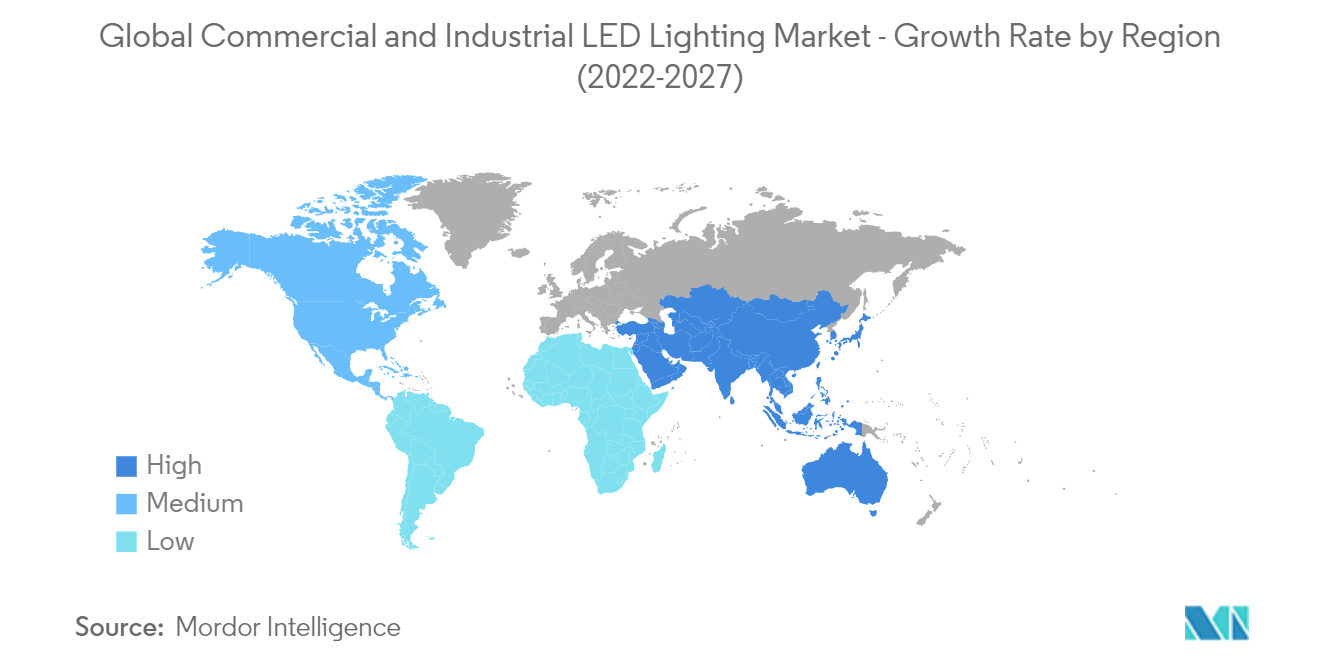Market Trends of Global Commercial and Industrial LED Lighting Industry
This section covers the major market trends shaping the Commercial & Industrial LED Lighting Market according to our research experts:
The Retail Segment is Expected to Drive the Market's Growth
- The demand for LED lighting in retail outlets is witnessing an upsurge, as several retailers worldwide are increasingly concerned about their impact on the environment. Retailers are responding by increasing the sustainability of their products and business practices. Improving efficiency and reducing waste lower overhead costs for retailers and provide an opportunity for business growth. To cater to the growing demand and intensifying competition, the players in the market are introducing innovative products & solutions and building robust partnerships and distribution networks.
- In May 2022, Mich.EarthTronics introduced its Color & Wattage Selectable LED Strip Series for high-bay and general lighting in retail and new commercial facilities. The company is dedicated to developing innovative energy-saving lighting products with a positive economic and environmental impact. The new LED Strip Series, which comes in 48- and 96-inch fixtures, allows facilities to switch between 3500K, 4000K, and 5000K color temperatures and three wattages during installation to provide the proper illumination level and desired color temperatures for optimum productivity.
- In March 2022, Fluence by OSRAM, a prominent global provider of energy-efficient LED lighting solutions for commercial cannabis and food production, announced its distribution partnership with HydrofarmHoldings Group, Inc., a significant manufacturer and distributor of hydroponic equipment and supplies for controlled environment agriculture. Hydrofarmwould begins distributing Fluence's newly released SPYDR Fang LED lighting solution to its network of hydro-shop retailers throughout the U.S. beginning in early April 2022.
- Moreover, among the retailers, it has been very important to show their products as they are being placed, especially when it comes to products like clothing. This means choosing the primarily designed lights to not distort the colors. The lights with high CRIs (color rendering index) become crucial. CRI primarily indicates how accurately a light source can reveal the true colors of objects, people, clothing, etc. This factor is likely to boost the growth of the studied market.
- Supermarkets have long been challenged to create an enticing atmosphere and successfully showcase their product assortments while simultaneously achieving energy efficiency and cost savings. With the older-generation lighting, such as fluorescent or halogen bulbs, proving to be inefficient, the retail sector is increasingly adopting modern LED lighting solutions that are known for imparting ambiance, enhancing fresh product appearance, and reducing spending on energy.

North America is Expected to Hold a Major Market Share
- The increasing demand for energy-efficient lighting systems, stringent government regulations, and declining prices of LED products are some of the major factors driving the adoption of LED lighting in the United States. For instance, In April 2021, the US Department of Energy announced six new initiatives to expand international cooperation around tackling the climate crisis and boosting clean energy innovation. These initiatives will boost the Biden Administration's 100% clean electricity goal by 2035 and net-zero carbon emissions by 2050. This would offer lucrative opportunities for the growth of the studied market.
- The US government is promoting the usage of LED lamps across various end-user verticals to increase energy efficiency. According to a report issued by the US Department of Energy, during 2017-2035, the number of installations of LED lamps in the commercial and residential building sectors may increase from 219 and 949 million lamp systems (MLS) in 2017 to 309 and 4038 MLS in 2035, respectively. Further, as per the US Department of Energy report published in March 2021, increased customer awareness of LED products and regulatory bodies, utility incentives, and rebate programs helped drive LED adoption; therefore, the market volume of LED lamps has grown exponentially.
- The governments in the region also regulate the lighting systems used in commercial spaces, limiting energy consumption. For example, the Federal Energy Management Program (FEMP) guides the acquisition of commercial light-emitting diode (LED) luminaires in the United States. Following suit, in July 2021, LumiledsHolding, with its operational headquarters in the United States, introduced its new LUXEON 2835 Commercial LEDs that are engineered and designed to support the increasing demand for a high volume, high-efficacy mid-power LED to serve commercial indoor lighting applications. Common commercial indoor applications include troffers, panels, and high-bay, among other formats.
- The North American industrial sector fosters the market's growth with increasing investments in industry-grade LED technologies. An industrial facility has multiple locations where high vibration, chemicals, debris, and potential explosives are present. These factors primarily impact the lifetime and performance of light fixtures installed within these locations. For example, aggregate processing and storage operations can have significant dust accumulation, while other chemical processing operations are highly acidic environments. As lighting technologies are evolving, there have been improvements in lifetime, energy efficiency, color, and safety. Furthermore, several market players are designing LED light fixtures for specific uses in hazardous and heavy industrial applications to ensure reliable, safe, and effective performance over the LED luminaire's life.
- In December 2021, Access Fixtures, a Massachusetts-based commercial and industrial lighting manufacturer, released a new family of explosion-proof light fixtures for industrial locations requiring vapor-tight and hazardous lighting. These fixtures are efficient and cost-effective at 140 lumens per watt and range in wattage from 40w to 200w. Lightweight die-cast aluminum ensures that even large fixtures weigh under 20 lbs for easy and safe mounting.
- On the Flipside, the outbreak of COVID-19 has led to a weakened growth of industrial output and the decline in light-manufacturing production across significant manufacturing hubs, owing to the halting of production and disruption in the supply chain across the United States. According to the US Department of Energy's report published in July 2021, many LED manufacturers cited a decreased demand for lighting products due to the challenges faced after the COVID-19 pandemic. Quarterly earnings dropped substantially for publicly traded LED lighting manufacturers.


